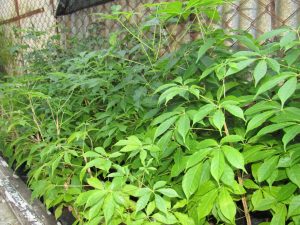
A landscape with silver blue highlights
by Edgardo Díaz
Edgardo travels to a savannah in Central Cuba where a Planta!‘s volunteer studies a population of Coccothrinax spirituana, the endemic blueish palm of this region.
Planta!’s volunteers stablish a new subpopulation of Rhodogeron coronopifolius, a rare Central Cuba species that grows between the rocks. Leaded by Faife and carrying a drill, punches and chisels, they open their way through the rock.
Date: 26/12/2019
Project: Assessment of the conservation status and recovery of Rhodogeron coronopifolius.
Hammers, chisels, shovels and even a drill were the coprotagonists of this peculiar field trip. Who would have thought that we were on our way to plant a small and fragile threatened plant? We looked for the exact spot along the river Sagua La Grande to stablish a new population of Rhodogeron coronopifolius, an exclusive species of the area.de estos parajes del centro de Cuba, cada vez menos extraña en ellos.
The site for planting was chosen during an expedition a few months ago. We started our trip about 7 am and once more we took the road towards the aqueduct that goes from Santa Clara’s city to Revacadero. We walked for about 5 Km along a narrow path towards the riverbed, but then the road deviates and the only way to continue is to follow the shoreline or to go across the water.
The plants were carried in boxes and soon enough they started to slow us down. At one point we decided to distribute the plants in several bags so we could share the weigh and make our task a little easier. Walking alongside the river reminded me of El Playazo, a site where we reinforced Rhodogeron coronopifolius a while ago. The reinforced population at this site shows a survival of 70%, making us feel proud and hopeful.
Finding the best spot for planting was not easy. I was worried that we were not going to be able to finish on time and that we might had to come back the next day. At about 10 am we finally found the right spot and we started planting.
More than biologists we looked like stone cutters. We used the drill to open small holes in the serpentine rock so the roots of the plants would be better attached. Many plants of the species stablish naturally this way.
Some individuals were planted scattered among other small plants called selaginellas, a relative of ferns. The roots of these plants help to retain the soil which benefits the newly planted rhodogerons. Our colleague Ignacio was by far the best planter. His reintroduced plants seemed like if they had been there for years.
Nine Biology students were trained on conservation methods before joining us in this expedition. Even though they were not used to this kind of intense field work, their contribution was significant. After 6 hours of uninterrupted work we finished all the planting.
Now I look in front of me and I am moved by the image of these 100 plants of Rhodogeron coronopifolius that are finally growing in an authentic riparian forest, just by the river and under the trees. Each one of them has a tag to monitor their growth. Each one has found where they belong at last.

by Edgardo Díaz
Edgardo travels to a savannah in Central Cuba where a Planta!‘s volunteer studies a population of Coccothrinax spirituana, the endemic blueish palm of this region.

by José Angel García-Beltrán
After planting 75 new royal oaks at Pan de Matanzas, this native species that came close to extinction, secures its future in the Island.

by José Angel García-Beltrán
Planta!‘s volunteers working on the protection of two cacti species from Eastern Cuba gather to share their results. This final meeting, which is also a time for planting and celebration, could be the beginning of new dreams.